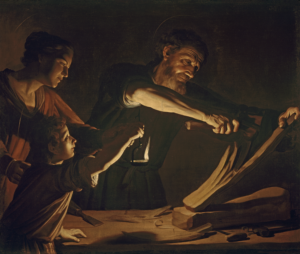Object of the Month: June 2015
The Holy Family in the Carpenter Shop
Oil on canvas
Gerrit van Honthorst, called Gherardo delle Notti
Dutch, 1592–1656
Click on the links throughout the article to view additional artists’ works and reference material.
Gerrit van Honthorst was a Dutch painter active during the early 17th century. Born in Utrecht, Holland in 1592, he was trained as an artist, as were two of his brothers. However, Gerrit became the most successful painter in his family. He was also the most famous member of a group called the “Utrecht Caravaggisti,” or those following the style of Michelangelo Merisi da Caravaggio in the northern European area called the Utrecht.
Honthorst is best known for taking Caravaggio’s example of dramatically using natural light and shadow and adapting the technique for nocturnal scenes with artificial light such as candles or lanterns to illuminate his paintings. This style trait gave him the nickname “Gherardo delle Notti” or “Gerard of the Night.”
Honthorst first studied in Utrecht, then lived and worked in Italy for several years before returning to the northern Netherlands in 1620. In 1622, he became a member of the Utrecht Guild of St. Luke and eventually served as its dean in the late 1620’s. Although Honthorst attracted international attention long before becoming a member of the guild, it was during this time, that he began to diversify from the Caravaggesque style by using less artificial light in his major works and made an extremely well-received visit to England, where he was given English citizenship and a lifetime pension (1628). After his return to Utrecht, his international reputation grew widely, especially among the royal and courtly circles in England and other nations.
M&G’s painting, The Holy Family in the Carpenter Shop, returns to the museum this month from an extended loan to the Uffizi Gallery in Florence, Italy, which featured a monograph exhibition showing Honthorst’s lifetime of work.
M&G’s painting is a classic example of the Utrecht Caravaggisti style of painting. The canvas is illuminated by a single candle-lit lantern, and the scene is both nocturnal and heavily shadowed. Honthorst depicts Mary, clothed in her symbolic red garments, helping a young Jesus hold the lantern high so that Joseph can see to carve in his woodshop. This portrayal invites the viewer into the intimate setting while also placing the family in an ordinary work environment.
Mollie Nelson, former M&G graduate assistant
Published in 2015
